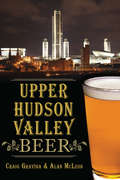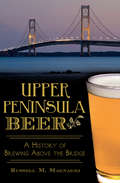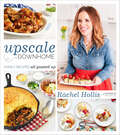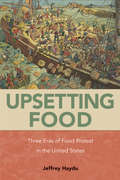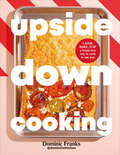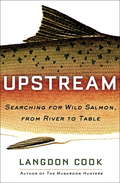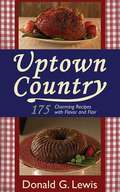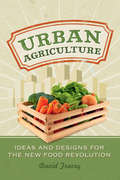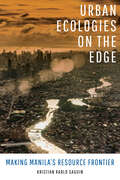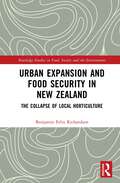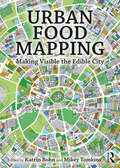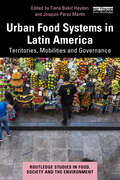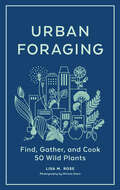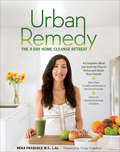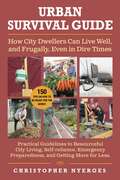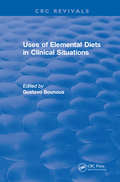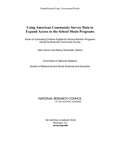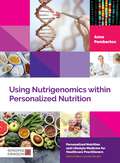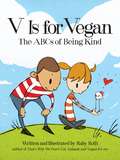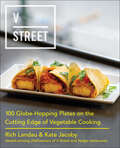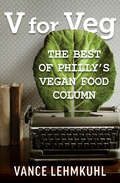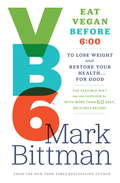- Table View
- List View
Upper Hudson Valley Beer (American Palate)
by Alan Mcleod Craig GravinaThe Upper Hudson Valley has a long and full-bodied brewing tradition. Arriving in the 1600s, the Dutch established the area as a brewing center, a trend that continued well into the eighteenth century despite two devastating wars. The Erie Canal helped develop Albany into a beer capital of North America--"Albany Ale" was exported across America and around the world. Upper Hudson Valley breweries continued to thrive until Prohibition, and some, like Beverwyck and Stanton, survived the dark years to revive the area's brewing tradition. Since the 1980s, there has been a renaissance in Upper Hudson Valley craft brewing, including Newman's, C.H. Evans, Shmaltz and Chatham Brewing. Beer scholars Craig Gravina and Alan McLeod explore the sudsy story of Upper Hudson Valley beer.
Upper Peninsula Beer: A History of Brewing Above the Bridge (American Palate)
by Russell M. MagnaghiBrewing came to the Upper Peninsula in the 1600s, when French fur traders substituted pine needles for hops in batches of spruce beer. Promoted as a health drink, the evergreen suds remained in favor with the British army when it occupied the region. German immigrants drawn in by the mining boom introduced more variety to the area's fermented beverage selection, and the first of many commercial breweries opened in Sault Ste. Marie in 1850. Today, Keweenaw, Blackrocks and Ore Dock Brewing Companies are a few of the local craft brewers canning, bottling and shipping the malty flavor of the Peninsula throughout Michigan, Wisconsin and beyond.
Uprisings: A Hands-On Guide to the Community Grain Revolution
by Sarah Simpson Heather McLeodThis practical guide explores the food security and community sufficiency benefits of growing local grain—and shows you how easy it is to get started.If we want to reduce our environmental impact, build resiliency in our community, and improve food security, it's up to us to make it happen. Uprisings shows how communities across North America can take action by reviving local grain production.Environmental journalist Sarah Simpson profiles of ten unique community models demonstrating how local grain production is already making a difference. She then shares step-by-step instructions for small-scale grain production that will turn any community into a hotbed of revolution. Learn about:How locally grown wheat, barley, and other grains can impact a communityHow to start a community grain project from scratchHow to plant, grow, harvest, thresh, winnow, and store your grainHow to use whole and sprouted grains in your kitchen
Upscale Downhome: Family Recipes, All Gussied Up
by Rachel HollisAffordable dishes presented so polished you’d never know their “lowbrow” origins, complete with fabulous hosting tips and tricks that don’t break the bank.Rachel Hollis, blogger and founder of “The Chic Site,” which reaches over 600,000 users a month, delivers this swoon-worthy cookbook packed with delicious and easy comfort food that’s sure to wow at both family suppers and the fanciest dinner parties.Rachel puts a finger-licking gourmet twist on classic American favorites in sections that include recipes for:Casseroles: balsamic bacon-wrapped meatloaf, bacon and green chili mac ‘n’ cheesePotluck: loaded baked potato salad, seven-layer saladDips: grilled guacamole, spicy corn dip, chili cheese dip, pepperoni pizza dipSips: strawberry and rosemary moonshine, Grandma’s sweet teaSomethin’ Sweet: banana pudding parfaits, Mema’s carrot cakePacked with big flavor and simple enough for a beginner home cook to master, Upscale Downhome focuses on great-tasting food and beautiful presentation that is guaranteed to impress. This is the kind of food that we all like to eat, served up with a chic twist.“If you’re a busy mom carting kids around, juggling schedules, maybe working too, you will love this book. And so will anyone forced to get food on the table fast, figure what to take to a potluck and desperate for something easy to serve guests.” —Local Food Eater“Great hacks for the hostess . . . Rachel Hollis will help you make your guests feel like VIPs without breaking your budget.” —Kitchen Chat
Upsetting Food: Three Eras of Food Protests in the United States
by Jeffrey HayduBattle lines have long been drawn over how food is produced, what food is made available to whom, and how best to protect consumers from risky or unhealthy food. Jeffrey Haydu resurrects the history of food reform and protest in Upsetting Food, showing how activists defined food problems, articulated solutions, and mobilized for change in the United States. Haydu’s sociological history starts in the 1830s with diet reformer Sylvester Graham, who blamed alcohol and store-bought bread—signs of a commercializing urban society—for poor health and moral decline. His successors at the turn of the twentieth century rallied against impure food and pushed for women to be schooled in scientific food preparation and nutrition. Decades later, in the 1960s and ’70s, a grassroots movement for organic food battled commercial food production in favor of food grown ecologically, by small farmers, and without artificial chemicals. Each campaign raised doubts about food safety, health, and transparency, reflecting how a capitalist system can undermine trust in food. But Haydu also considers how each movement reflects the politics, inequalities, and gender relations of its time. And he traces how outcomes of each campaign laid the groundwork for the next. The three eras thus come together as parts of a single, recurring food movement. Upsetting Food offers readers a historical background to better understand contemporary and contentious food politics.
Upside Down Cooking: LAYER, BAKE, FLIP A Brand New Way to Cook in One Tray
by Dominic FranksThe book that flips your kitchen upside down, with joyfully delicious results. Dominic Franks (@dominthekitchen) shows you how to play with your food and cook easy, impressive meals for every occasion. This is one-pan cooking like you've never seen it before. With 85 recipes including twists on classic one-pot dishes – from mini puff pizzas to chicken pot pies, blueberry muffin traybakes to banana toffee tarts – Dom gives you the confidence to remix your own one-tray dinners, plus sides, snacks, party treats, and desserts. Simply layer up tasty ingredients in a single pan, cover with puff pastry and other fabulous toppings, bake to gloriously golden perfection – and you’ll be turning out stunning upside down creations in no time at all. No fuss, minimal washing up, and never a soggy bottom in sight!
Upstream: Searching for Wild Salmon, from River to Table
by Langdon CookFrom the award-winning author of The Mushroom Hunters comes the story of an iconic fish, perhaps the last great wild food: salmon. For some, a salmon evokes the distant wild, thrashing in the jaws of a hungry grizzly bear on TV. For others, it’s the catch of the day on a restaurant menu, or a deep red fillet at the market. For others still, it’s the jolt of adrenaline on a successful fishing trip. Our fascination with these superlative fish is as old as humanity itself. Long a source of sustenance among native peoples, salmon is now more popular than ever. Fish hatcheries and farms serve modern appetites with a domesticated “product”—while wild runs of salmon dwindle across the globe. How has this once-abundant resource reached this point, and what can we do to safeguard wild populations for future generations? Langdon Cook goes in search of the salmon in Upstream, his timely and in-depth look at how these beloved fish have nourished humankind through the ages and why their destiny is so closely tied to our own. Cook journeys up and down salmon country, from the glacial rivers of Alaska to the rainforests of the Pacific Northwest to California’s drought-stricken Central Valley and a wealth of places in between. Reporting from remote coastlines and busy city streets, he follows today’s commercial pipeline from fisherman’s net to corporate seafood vendor to boutique marketplace. At stake is nothing less than an ancient livelihood. But salmon are more than food. They are game fish, wildlife spectacle, sacred totem, and inspiration—and their fate is largely in our hands. Cook introduces us to tribal fishermen handing down an age-old tradition, sport anglers seeking adventure and a renewed connection to the wild, and scientists and activists working tirelessly to restore salmon runs. In sharing their stories, Cook covers all sides of the debate: the legacy of overfishing and industrial development; the conflicts between fishermen, environmentalists, and Native Americans; the modern proliferation of fish hatcheries and farms; and the longstanding battle lines of science versus politics, wilderness versus civilization. This firsthand account—reminiscent of the work of John McPhee and Mark Kurlansky—is filled with the keen insights and observations of the best narrative writing. Cook offers an absorbing portrait of a remarkable fish and the many obstacles it faces, while taking readers on a fast-paced fishing trip through salmon country. Upstream is an essential look at the intersection of man, food, and nature.Praise for Upstream“Passionate . . . Cook deftly conveys his love of nature, the beauty of the Pacific Northwest, and the delectable eating provided by fresh caught wild salmon.”—Library Journal “Insightful . . . this work is a great place to learn what needs to done—and an entertaining view on the positive and negative connections humans have with the natural environment.”—Publishers Weekly“Langdon Cook delivers a beautifully written portrait of the iconic salmon that blends history, biology, contentious politics, and the joy of fishing into a captivating and thought-provoking tale.”—Eric Jay Dolin, author of Brilliant Beacons“Salmon are the essence of the Pacific Northwest, and as Langdon Cook shows so powerfully, they are the key to its future."—Rowan Jacobsen, author of The Essential Oyster“In this fresh tale of an ancient wonder, Langdon Cook takes us on an inspired journey of discovery through the heart and soul of salmon country.”—David R. Montgomery, author of King of Fish and Growing a Revolution
Uptown Country: 175 Charming Recipes with Flavor and Flair
by Donald G. LewisDrawn from the days when author Donald Lewis watched his grandmother churn butter and gather fresh eggs to use in family meals, these country dishes have a contemporary flair that's perfect for even the most elegant brunch or dinner party. You'll find recipes for such classic treats as Creamy Onion Soup, Squash Bisque, Creole Seafood Gumbo, Baked Chicken Breasts with Roast Garlic Sauce, Velvet Almond Fudge Cake, Lemon Date Squares, and Apple Spice Muffins. There's also a useful conversion chart for British and American measures and temperatures, a handy list of ingredient substitutions, a recipe for a "Master Mix" that can be used for a range of baked goods, and general herb suggestions for flavoring foods to perfection. This is a charming cookbook that skillfully combines rural country cooking with modern culinary style.
Urban Agriculture
by David TraceyUrban Agriculture is packed with ideas and designs for anyone interested in joining the new food revolution. First-time farmers and green thumbs alike will find advice on growing healthy, delicious, affordable food in urban settings. From condo balconies to community orchards, cities are coming alive with crops. Get growing!
Urban Ecologies on the Edge: Making Manila's Resource Frontier
by Kristian Karlo SaguinLaguna Lake, the largest lake in the Philippines, supplies Manila's dense urban region with fish and water while operating as a sink for its stormflows and wastes. Transforming the lake to deliver these multiple urban ecological functions, however, has generated resource conflicts and contradictions that unfold unevenly across space. In Urban Ecologies on the Edge, Kristian Karlo Saguin tracks the politics of resource flows and unpacks the narratives of Laguna Lake as Manila's resource frontier. Provisioning the city and keeping it safe from floods are both frontier-making processes that bring together contested socioecological imaginaries, practices, and relations. Combining fieldwork and historical accounts, Saguin demonstrates how people—powerful and marginalized—interact with the state and the environment to produce the unequal landscapes of urbanization at and beyond the city's edge.
Urban Expansion and Food Security in New Zealand: The Collapse of Local Horticulture (Routledge Studies in Food, Society and the Environment)
by Benjamin Felix RichardsonThis book examines suburban development in New Zealand and its conflict with and impact on local horticulture and food security. Drawing on an ethnographic study of Auckland’s rapidly expanding urban periphery, combined with comparative case studies from California in the USA and Victoria in Australia, the book examines how the profit-making strategies of property developers and landowners drastically reshapes work and life at the edge of cities. With a significant portion of the world's croplands lying adjacent to cities, the accelerating pace of urban sprawl across the planet places unprecedented pressure on the productivity and even existence of these vital food bowl regions. The book examines how the demand for more land for development at the urban periphery collides with concerns over local food security and the protection of ecosystem services. It analyses land use policy, historical records, and physical patterns of development, alongside participant observation of local events. It combines this with interviews with government officials, property developers, landowners, local residents and horticulturists. By combining these narratives of the hectic and lucrative business of suburban property development with the collapse of local horticulture, this book shows how the realignment of the New Zealand's interests of financial profitability over other concerns led to the transformation of urban peripheries from a productive food bowl to an investment vehicle. This book will be of great interest to students and scholars of urban food and agriculture, urban planning and development and rural-urban studies.
Urban Food Mapping: Making Visible the Edible City
by Katrin Bohn Mikey TomkinsWith cities becoming so vast, so entangled and perhaps so critically unsustainable, there is an urgent need for clarity around the subject of how we feed ourselves as an urban species. Urban food mapping becomes the tool to investigate the spatial relationships, gaps, scales and systems that underlie and generate what, where and how we eat, highlighting current and potential ways to (re)connect with our diet, ourselves and our environments.Richly explored, using over 200 mapping images in 25 selected chapters, this book identifies urban food mapping as a distinct activity and area of research that enables a more nuanced way of understanding the multiple issues facing contemporary urbanism and the manyfold roles food spaces play within it. The authors of this multidisciplinary volume extend their approaches to place making, storytelling, in-depth observation and imagining liveable futures and engagement around food systems, thereby providing a comprehensive picture of our daily food flows and intrastructures. Their images and essays combine theoretical, methodological and practical analysis and applications to examine food through innovative map-making that empowers communities and inspires food planning authorities. This first book to systematise urban food mapping showcases and bridges disciplinary boundaries to make theoretical concepts as well as practical experiences and issues accessible and attractive to a wide audience, from the activist to the academic, the professional and the amateur. It will be of interest to those involved in the all-important work around food cultures, food security, urban agriculture, land rights, environmental planning and design who wish to create a more beautiful, equitable and sustainable urban environment.
Urban Food Systems in Latin America: Territories, Mobilities and Governance (Routledge Studies in Food, Society and the Environment)
by Tiana Bakić Hayden Joaquín Pérez MartínDrawing on a range of case studies from across Latin America, this book highlights the ways that urbanization shapes the food systems that feed this region’s cities, approaching the problem of food in cities as a particularly urban problem.Latin America is the most urbanized area in the world, with nearly 80% of the population living in cities, where rates of food and nutritional insecurity are persistently high, and where the social and spatial organization is characterized by inequality and segregation. The broader questions addressed in this volume are as follows: How do the specific processes and dynamics of Latin American urbanization influence or shape food systems? How can urban food systems develop forms of governance that supports food security and sustainability? After a general introduction, this volume is organized into three main sections: Territories, mobilities, and governance. The chapters consider how specific elements such as urban planning, zoning, migration, gentrification, informal settlements, logistics, retailers, wholesale markets and street vendors, among others, contribute to shaping how food is distributed, sold, and bought in cities. Drawing on studies and theoretical approaches written by scholars and practitioners from Argentina, Brazil, Chile, Ecuador and Mexico, this book provides a Latin American perspective on global discussions surrounding the role of cities in ensuring food access to urban populations.This volume will be of great interest to students, scholars, and policymakers interested in food systems, urban food, urban planning, sustainable urban development, and Latin American studies.
Urban Foraging: Find, Gather, and Cook 50 Wild Plants
by Lisa M. RoseYour city is full of wild food, you just need to know where to find it. Take a stroll to discover the ingredients for a wild apple tarte tatin. Turn the lilac bush found in a vacant lot into a delicious, delicately flavored jelly for your morning pastry. Discover a new way to feast on fresh food. Urban Foraging is a stylish, scrumptious guide to wildcrafting in the city. You&’ll learn how to find, identify, harvest, and cook with 50 common wild plants, such as chickweed, dandelion, echinacea, honeysuckle, red clover, and pine. Expert forager Lisa M. Rose shares all the basics necessary for a successful harvest: clear photos that aid identification, tips for ethical and safe gathering, details on culinary uses, and simple recipes will help you make truly fresh, nutritious meals.
Urban Remedy: The 4-Day Home Cleanse Retreat
by Neka PasqualeA holistic meal and activity plan to detox and reset your health—includes a foreword by Cindy Crawford. This comprehensive handbook offers a complete whole-food cleansing plan along with guidelines for how to prepare for, enjoy, and come back from your cleanse. With a holistic mind-and-body approach, this program will help you break out of bad habits, reset routines and intentions, and improve your overall health and wellbeing. Urban Remedy includes information on: The benefits of cleansingWhat to expect from your Urban Remedy cleanse retreatComplete equipment and shopping lists for planning your daysStep-by-step instructions for each day of the cleanseA section on treating ailments through food based on ancient healing principlesMore than 75 mostly raw and vegan recipes for living well every day &“Whether it&’s a three-day cleanse, a single day of clean eating, or a particular recipe to treat a common ailment, I look to Neka for delicious, healing recipes that will help me feel my best.&”—Cindy Crawford, from the foreword
Urban Survival Guide: How City Dwellers Can Live Well, and Frugally, Even in Dire Times
by Christopher NyergesPractical Guidelines to Resourceful City Living, Self-reliance, Emergency Preparedness, and Getting More for Less A survival guidebook that reflects the world in which we now find ourselves. The post 9/11 world seems a bit more hostile, as terrorist threats and attacks are no longer a surprise. The Great Tsunami of Christmas 2004 showed us that quick extinctions (like Noah&’s flood) can and do happen without apparent warning. Hurricanes Katrina and Sandy not only told us that it can happen to us, but that it is foolhardy to make no preparations and pretend that the government will take care of you in the post-disaster landscape. The price of gold id rising again. War, rumors of war, famines, political instability, economic instability, global pandemics – all these and more are causes of concern to the average family. Economic survival is also addresses, since this is such a fundamental building block of everything else in modern society. Money cannot be ignored.
Uses of Elemental Diets in Clinical Situations
by G. BounousThe studies presented in this book demonstrate that a new concept in the management of carious intestinal disorders should be considered, namely, that common nutrients may protect or heal the mucosa by virtue of the particular form and mode in which they are delivered to the intestinal lumen and their availability to the mucosal cells. The substitution of intact protein in the formula by hydrolysate appears to me an important factor.
Using American Community Survey Data to Expand Access to the School Meals Programs
by Panel on Estimating Children Eligible for School Nutrition Programs Using the American Community SurveyThe National School Lunch and School Breakfast Programs, administered by the Food and Nutrition Service (FNS) of the U. S. Department of Agriculture (USDA), are key components of the nation's food security safety net, providing free or low-cost meals to millions of schoolchildren each day. To qualify their children each year for free or reduced-price meals, many families must submit applications that school officials distribute and review. To reduce this burden on families and schools and to encourage more children to partake of nutritious meals, USDA regulations allow school districts to operate their meals programs under special provisions that eliminate the application process and other administrative procedures in exchange for providing free meals to all students enrolled in one or more school in a district. FNS asked the National Academies' Committee on National Statistics and Food and Nutrition Board to convene a panel of experts to investigate the technical and operational feasibility of using data from the continuous American Community Survey (ACS) to estimate students eligible for free and reduced-price meals for schools and school districts. The ACS eligibility estimates would be used to develop "claiming percentages" that, if sufficiently accurate, would determine the USDA reimbursements to districts for schools that provided free meals to all students under a new special provision that eliminated the ongoing base-year requirements of current provisions. Using American Community Survey Data to Expand Access to the School Meals Program was conducted in two phases. It first issued an interim report (National Research Council, 2010), describing its planned approach for assessing the utility of ACS-based estimates for a special provision to expand access to free school meals. This report is the final phase which presents the panel's findings and recommendations.
Using Nutrigenomics within Personalized Nutrition: A Practitioner's Guide (Personalized Nutrition and Lifestyle Medicine for Healthcare Practitioners)
by Anne PembertonThis is the comprehensive guide to utilising nutrigenomics in clinical practice. A cutting-edge field, nutrigenomics examines the effects of foods on gene expression. From a comprehensive patient history and appropriate testing, practitioners can work with the patient to correct underlying biochemical imbalances that may predispose to a disease, using nutrigenomics as a guidance tool. The book covers everything a practitioner needs to know, from the difference between nutrigenomics and epigenetics to what to consider when incorporating nutrigenomics with functional medicine. The book is highly practical, guiding the reader through the realities of using genetic testing in clinical practice.
V Is for Vegan: The ABCs of Being Kind
by Ruby RothIntroducing three- to seven-year-olds to the "ABCs" of a compassionate lifestyle, V Is for Vegan is a must-have for vegan and vegetarian parents, teachers, and activists! Acclaimed author and artist Ruby Roth brings her characteristic insight and good humor to a controversial and challenging subject, presenting the basics of animal rights and the vegan diet in an easy-to-understand, teachable format. Through memorable rhymes and charming illustrations, Roth introduces readers to the major vegan food groups (grains, beans, seeds, nuts, vegetables, and fruits) as well as broader concepts such as animal protection and the environment. Sure to bring about laughter and learning, V Is for Vegan will boost the confidence of vegan kids about to enter school and help adults explain their ethical worldview in a way that young children will understand. From the Hardcover edition.
V Street: 100 Globe-Hopping Plates on the Cutting Edge of Vegetable Cooking
by Kate Jacoby Rich LandauA dazzling collection of more than 100 innovative, globe-hopping vegetable recipes from the acclaimed Philadelphia restaurant V Street.Inspired by the great ethnic and street foods of the world, chefs Rich Landau and Kate Jacoby bring a variety of bold flavors to their devoted clientele. Now, home cooks can recreate the same exceptional dining experience with these zesty, mouthwatering recipes that whet the appetite and feed the imagination.In V Street, Landau and Jacoby offer creative vegan riffs on street food from across the globe—drawing from the culinary traditions of Asia, the Middle East, South America, and more—in a diverse range of dishes including:Sticks: Jerk Trumpet Mushrooms, Shishito RobotayakiSnacks: 5:00 Szechuan Soft Pretzels, Papadums with Whipped DalSalads: Jerk Sweet Potato Salad, Tandoori EggplantMarket: Harissa Grilled Cauliflower, Peruvian FriesPlates: Black Garlic Pierogies, Hearts of Palm & Avocado SoccaBowls: Dan Dan Noodles, Kimchi StewSweets: Churro Ice Cream Sandwich, Sweet Potato AranciniCocktails: Hong Kong Karaoke, Lokum at the BazaarFilled with 100 internationally inspired recipes, behind-the-scenes anecdotes, food travel stories, and stunning color photography throughout, this casual companion cookbook to Vedge is a must-have for vegetable lovers and everyone with a taste for adventure.
V for Veg: The Best of Philly’s Vegan Food Column
by Vance LehmkuhlV for Veg is a collection of the vegan food columns that Vance Lehmkuhl has written over the years for the Philadelphia Daily News. Filled with wit, humor and good information about the vegan/vegetarian plant-based community in Philadelphia, the book covers many of the events, personalities, restaurants, and industries that have grown up in and around Philadelphia. Combining healthful information with a sly, humorous style, Vance Lehmkuhl’s book will delight the veg-conscious and may spur many a meat eater to explore the animal-free options now available for feeding all aspects of our lives.
V is for Vegetables: Inspired Recipes & Techniques for Home Cooks - from Artichokes to Zucchini
by Dorothy Kalins Michael AnthonyOne of America's most highly acclaimed chefs gives us more than 140 simple recipes and techniques for imaginative vegetable cooking at home. Gramercy Tavern's Executive Chef Michael Anthony believes a cook's job is to create delicious flavors and healthy meals. Written for the home cook, V IS FOR VEGETABLES celebrates the act of cooking vegetables he loves. Anthony shows how unlocking the secrets of vegetables can be as simple as roasting a beet, de-knobbing a Jerusalem artichoke, peeling a gnarly celery root, slicing a bright radish, washing a handful of just-picked greens. V IS FOR VEGETABLES is personal, accessible, and beautiful. Its charming A to Z format celebrates vegetables in richly detailed illustrations, glorious food photographs, and lots of helpful how to do it techniques. Recipes include crispy composed salads, fresh herb sauces, satisfying warm gratins, vibrant stews, simple sautéed greens over a bowl of grains, and veggies with meat and fish, too. V IS FOR VEGETABLES delivers the tools to transform and conquer the vegetables in a CSA basket, from the farmers market, and even the grocery store. It is an eye-opening book for vegetarians and omnivores alike.
VB6: Eat Vegan Before 6:00 to Lose Weight and Restore Your Health . . . for Good
by Mark Bittman“I live full-time in the world of omnivores, and I’ve never wanted to leave. But the Standard American Diet (yes, it’s SAD) got to me as it gets to almost everyone in this country.” Six years ago, an overweight, pre-diabetic Mark Bittman faced a medical directive: adopt a vegan diet or go on medication. He was no fan of a lifelong regimen of pills, but as a food writer he lived—and worked—to eat. So neither choice was appealing. His solution was a deal with himself. He would become a “flexitarian.” He adopted a diet heavy in vegetables, fruits, and grains by following a healthy vegan diet (no meat, dairy, or processed foods) all day. After 6:00 p.m. he’d eat however he wanted, though mostly in moderation. Beyond that, his plan involved no gimmicks, scales, calorie counting, or point systems. And there were no so-called forbidden foods—he ate mostly home-cooked meals that were as varied and satisfying as they were delicious, but he dealt with the realities of the office and travel and life on the run as best he could. He called this plan Vegan Before 6:00 (VB6 for short), and the results were swift and impressive. Best of all, they proved to be lasting and sustainable over the long haul. Bittman lost 35 pounds and saw all of his blood numbers move in the right direction. Using extensive scientific evidence to support his plan, the acclaimed cookbook author and food policy columnist shows why his VB6 approach succeeds when so many other regimens not only fail, but can actually lead to unwanted weight gain. He then provides all the necessary tools for making the switch to a flexitarian diet: lists for stocking the pantry, strategies for eating away from home in a variety of situations, pointers for making cooking on a daily basis both convenient and enjoyable, and a complete 28-day eating plan showing VB6 in action. Finally, Bittman provides more than 60 recipes for vegan breakfasts, lunches, and snacks, as well as non-vegan dinners that embrace the spirit of a vegetable- and grain-forward diet. If you’re one of the millions who have thought of trying a vegan diet but fear it’s too monotonous or unfamiliar, or simply don’t want to give up the foods you love to eat, VB6 will introduce a new, flexible, and quite simply better way of eating you can really live with . . . for life. From the Hardcover edition.
VB6: Eat Vegan Before 6:00 to Lose Weight and Restore Your Health ... for Good
by Mark Bittman"I live full-time in the world of omnivores, and I've never wanted to leave. But the Standard American Diet (yes, it's SAD) got to me as it gets to almost everyone in this country."Six years ago, an overweight, pre-diabetic Mark Bittman faced a medical directive: adopt a vegan diet or go on medication. He was no fan of a lifelong regimen of pills, but as a food writer he lived--and worked--to eat. So neither choice was appealing.His solution was a deal with himself. He adopted a diet heavy in vegetables, fruits, and grains by following a healthy vegan diet (no meat, dairy, or processed foods) all day. After 6:00 p.m. he'd eat however he wanted, though mostly in moderation. Beyond that, his plan involved no gimmicks, scales, calorie counting, or point systems. And there were no so-called forbidden foods--he ate mostly home-cooked meals that were as varied and satisfying as they were delicious, but he dealt with the realities of the office and travel and life on the run as best he could.He called this plan Vegan Before 6:00 (VB6 for short), and the results were swift and impressive. Best of all, they proved to be lasting and sustainable over the long haul. Bittman lost 35 pounds and saw all of his blood numbers move in the right direction.Using extensive scientific evidence to support his plan, the acclaimed cookbook author and food policy columnist shows why his VB6 approach succeeds when so many other regimens not only fail, but can actually lead to unwanted weight gain.He then provides all the necessary tools for making the switch to a "flexitarian" diet: lists for stocking the pantry, strategies for eating away from home in a variety of situations, pointers for making cooking on a daily basis both convenient and enjoyable, and a complete 28-day eating plan showing VB6 in action. Finally, Bittman provides more than 60 recipes for vegan breakfasts, lunches, and snacks, as well as non-vegan dinners that embrace the spirit of a vegetable- and grain-forward diet.If you're one of the millions who have thought of trying a vegan diet but fear it's too monotonous or unfamiliar, or simply don't want to give up the foods you love to eat, VB6 will introduce a new, flexible, and quite simply better way of eating you can really live with . . . for life.
